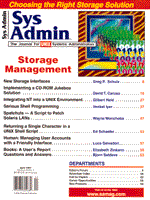
Editor's Forum
Although we once considered trading our first-born children for 1.2 Gb drives for the server, such disks are now considered minimal for desktop PCs. With the increased demands of multi-media storage, bandwidth and transfer rates are far more important today than in the past. Along with increased disk capacities, several new tape technologies are emerging. Quantum's AB" Digital Linear Tape (DLT) now offers a capacity of 40 Gb per tape cartridge, uncompressed, while competing technologies, such as Advanced Intelligent Tape (AIT) from Sony and Exabyte's Mammoth drives, provide capacities in the 20-25 Gb per tape range on 8 mm helical scan tape. Even the venerable QIC format is getting a new shot in the arm with Tandberg Data's MLR1 drive that squeezes 13 Gb, uncompressed, onto the new DC13 quarter-inch tapes. Several of these high-capacity tape formats are also available in libraries, combining multiple tape drives with autoloaders that can access scores of optionally barcoded tapes. IBM's Storage Systems Division has even updated the mainframe-era concept of tape-based near-line storage by designing a new cartridge tape system that rewinds to the center of the tape, thereby cutting average data access times in half. Hierarchical Storage Management (HSM), in which inactive files are migrated from disk to less expensive media such as optical storage or tape, is also one of the choices that may be part of your storage management strategy. Optical jukeboxes, available from numerous manufacturers, can provide a viable alternative to neverending increases in hard disk storage in corporate environments. At the low end, recordable compact disc drives (CDR), available from well-known vendors such as Philips and Pinnacle, combined with CD-ROM arrays or four-disc autochanger CD-ROM drives, such as Nakamichi's M.J.-4.8s, can provide an economical solution for archives of static data. Here, too, numerous manufacturers provide higher end jukebox solutions that combine CDR drives with standard CD-ROM drives and robotics to provide relatively fast access to scores of gigabytes of data. The real challenge in storage management today, however, is to keep your planning of these choices one or two steps ahead of requirements. As Web servers and intranets become an integral part of corporate culture, and the storage of multimedia data types increases, your life will be easier if you already have a storage management strategy in place. Although a wealth of almost-immediately available data may increase the efficiency of knowledge workers and improve their business decisions, the system administration requirements that are associated with such storage should not be ignored. Thus, in planning which of the vast array of storage technology choices are appropriate for your organization, remember to consider which disk and tape technologies will be most efficient for you to administer, which technologies match your data interchange requirements, and what storage management software you might need to maintain sanity.
Sincerely yours,
|